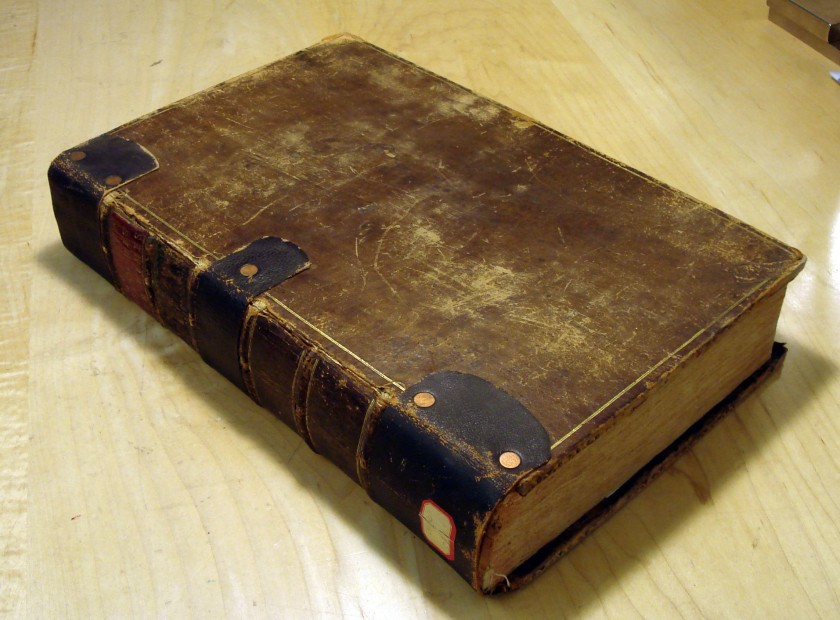I’m currently in the middle of my book conservation fellowship at the Boston Athenæum. The library’s collection is full of strange and unusual things, but the other day a book came through the lab with a previous repair that I had never seen before.
This is a quarto-sized volume with heavy boards that, at one point, had separated entirely from the book. Rather than go through the time-consuming process of rebacking or rebinding this volume, someone created a new board attachment with three strips of thick leather and a couple of brass rivets. Here is a detail of the head:
I’m actually kind of impressed with how neatly this repair was done. The leather repair strips are adhered firmly to the spine and along the boards. While the heads of the rivets are large, they sink down into the thickness of the leather repairs, so there is no danger of them catching or scratching the companion volumes on the shelf. The ends of the leather strips on the board are also cut into a pleasing curve.
 Here is an overview shot of the inside of the board.
Here is an overview shot of the inside of the board.
While the rivet heads on the inside sit a bit proud of the board surface, I do not observe any damage or discoloration to the paste-down or title page. While crude, the repair functions very well – maintaining a strong attachment, while allowing the boards to open easily.
This book came to the Athenæum in the early 1950’s. The conservators have not seen other volumes in the collection treated in the same way, so we can assume this repair was done before the book entered the collection.
Looking at the full-thickness leather and quality of the rivets, I honestly wonder if this was done by someone whose primary business was not books at all: perhaps a cobbler or saddle maker. The novelty of the repair makes me think that a previous owner brought the book to some tradesman who had some spare leather and a riveting machine in their shop and asked them to “give it a go” on some book repair. Is this method of board attachment unique or just uncommon. If you have seen something like this before, please comment below.




These three ‘spine straps’ remind me of mid 18th to early 19th century style of binding often found on liturgical books. Pensylvania German Bindings often have these and they are often found on Martyrs’s Mirror. One style of this binding is often found with thick wooden boards, metal corner pieces, metal top and bottom edge guards, and three spine straps. The straps are held on with rivets or bosses, and sometimes the straps themselves decorated with metalwork. This style of binding is also found in Europe. There is an article about Latvian ones in Library History, Volume 24, Number 2, June 2008 , pp. 128-142 There is a lot of speculation, but little evidence, that this style of binding is related to harness makers or others in associated leather crafts.
I haven’t seen this style used as a repair, though it does fit into a nineteenth century paradigm of relying on mechanical, rather than adhesive strength. Great post. Jeff Peachey